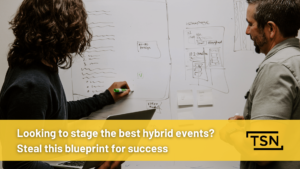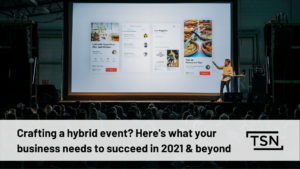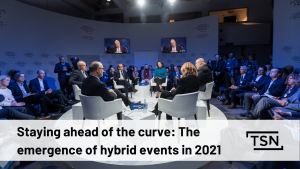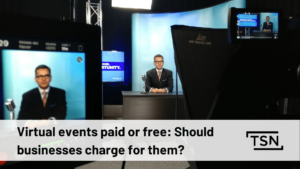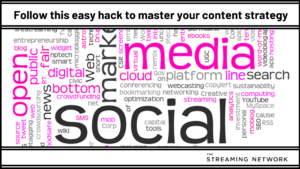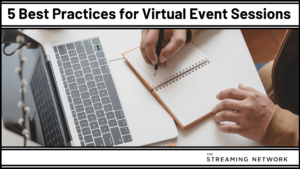Podcast: Play in new window | Download | Embed
Subscribe: Apple Podcasts | Google Podcasts | RSS
Lessons From The Frontline
In our last episode, we discussed a popular content strategy for when you’re in need of some inspiration; repurposing webinar content.
You can leverage existing content such as your:
- Blogs.
- Podcasts.
- Webinars.
- Lead Magnets.
- Email Campaigns.
- Etc.
For instance, we repurpose our lead magnets (curated with the help of Demand Metric) and webinars as blog content.
This week, Peter and I are continuing our discussion on repurposing webinar content in further detail.
We will be tackling the following topics:
- Different people like to consume content differently: A C-level executive may not have the bandwidth to watch a full webinar, but they will settle for a snackable piece of content. However, a director or manager who is looking for better solutions to resolve one of their pain points may be more willing to watch a longer-form piece of content. This is to gather insights about what it is you are offering. Create the appropriate types of content for both audiences.
- Are you creating assets that are truly valuable to your audience?: Conduct your own research into what your audience values. Create content pieces or toolkits (assets) from that. Track what assets are downloaded – you’ll have an idea of where your audience stands in their webinar journey.
- Content ideas for professional services: For those in financial and legal services, your content is reactive to what is currently happening in the world. Locate one over-aching message that your audience cares about. Build content surrounding that. For instance, what can your audience expect to happen in the next 12 months based on a change in your industry that affects them?
- Tips and tricks on repurposing content: Create a memorable hook that leaves a good impression on your audience with a particular anecdote or story that you find yourself using repeatedly. Check out our series on “The Art of Storytelling” with Ron Tite to learn more about creating these captivating stories.
The Complete Video Transcript
Peter Vamos: Welcome back to part two of our discussion around taking content and repurposing it. This is LFTF, “Lessons from the Frontline.” With me, again, is Matthew Ley, President of The Streaming Network. Welcome again.
Matthew Ley: Thanks for having me, Pete. So, you kept the fire burning.
Peter Vamos: Kept the fire burning. It’s–it’s getting warmer and warmer by the minute.
Matthew Ley: Yep.
Peter Vamos: I have no idea whether it’s actually the fire or just my–I’m getting some–some hot flashes.
Matthew Ley: I was watching the last one from the–from the–I think it must have been a little bit warmer than it was today. And I was seeing that, by the end, we had–we had a little bit of sweat going.
Peter Vamos: Yeah.
Matthew Ley: We got–we worked up–you know, we worked up a little bit of a sweat.
Peter Vamos: Some vigorous conversation.
Matthew Ley: Vigorous, yeah.
Peter Vamos: Yeah. I know you can’t see this side of my face. But, it’s completely red. So, we–we sort of finished off talking about what works well in terms of topics and–and formats when you’re repurposing content.
Matthew Ley: Yeah.
Peter Vamos: We had a really great conversation in terms of using webinars. We talked about the ROI webinar and–and you broke that down for us.
Matthew Ley: Yeah.
Peter Vamos: One of the things I found interesting as–as we left that off–and you mentioned that one of the pieces of content or one of the–one of the assets that came out of that was–was report card, the webinar report card.
Matthew Ley: Right.
Peter Vamos: And I found it interesting because that, in it of itself, is not–I mean, it is a piece of content.
Matthew Ley: Yeah.
Peter Vamos: But, it becomes a leads generation tool as well. All content is sort of a leads generation tool. But, this is very much the sort of thing that you put on landing pages, that you can actually drive leads and–and people come and sign in and–and–and give you their email addresses.
Matthew Ley: Yeah.
Peter Vamos: So, I–I’d like to talk a little bit about that, like how–what other types of content you can generate from–from this raw content and sort of dig in a little bit about how that works, I guess, within the lead purchase mode.
Matthew Ley: Yeah, yeah. So, I’m not going to start with the report cards since it was last.
Peter Vamos: Yeah.
Matthew Ley: But, you are right, I mean, in that all these can generate leads to a certain extent. But, the different types of content are used for different people and at different points in the–in the funnel, if you will.
So, what we–what we know about people is they like–different people like to consume content differently.
So, even within the realm of video, is that–if you’re got an executive who needs to buy in on a project, there’s not a good–there’s not a likelihood they’re going to sit there and watch 20 minutes or 40 minutes of us talking about repurposing content.
They might, you know, if they’re an executive that comes from the marketing side and they’re interested in our discussion or they like the cut of your jib.
But, generally speaking, they’re not going to. They’re going to watch a segment that we put out, a short segment, probably that 30 second to two minutes buzz worth piece that will go out on social that will lead him to us and say, “Hey, this is something that I want to investigate.”
And then, you’ve got sort of the department head, manager level. And, in video, we–they usually say they’re going to watch about a five minute video.
They want to get enough meat on the bones that they recognize this is a company that they should be talking to or looking at more.
But, they’ll likely pass that on to somebody else. And that’s where things like webinars and long format content come in, podcasts, webinars, and the like–is that’s somebody who’s really digging in and trying to learn something.
So, anyone who spends 40 minutes with us or whatever this, you know, total of the repurposing comes in is someone who’s trying to learn how to repurpose content in general.
So, we always format our video and have for some time in such a way that we can, at minimum, get that long webinar piece and the four to five minute clip piece because we find that’s where most of our buyers are at.
But, there are those people who like to read as well. I mean, at minimum, transcribe what you do and put it online.
It’s great for SEO. But, it also is good for those people who like to read. It makes it easier if you’re using ghost writers and the like or you’re marketer is writing content for you to take what you said and turn it into something that can be read or is–or is easily read.
And it can just be literally that, a–.
Matthew Ley: –It can be–yeah–.
Peter Vamos: –Send it out to transcription and come back. You–.
Matthew Ley: –I–you know what? Yeah, you can do–I think–.
Peter Vamos: –It can be that.
Matthew Ley: It can be that, yes.
Peter Vamos: It can be a little more–.
Matthew Ley: –There’s value in that. But, I think that if you are going to do a blog that–that people read differently than we talk and that you should polish it, maybe add some more stats or some imagery to it–.
Peter Vamos: –Write it as an article, what we talked about as an–as an actual article.
Matthew Ley: Yeah.
Peter Vamos: Makes sense.
Matthew Ley: Like what you took away from it more than anything else. But, it–but, there is value in both, right? And why miss any of these opportunities in this day and age?
And so, usually the–the–the videos of any sort, the short or the long format, are ungated content. Blogs are ungated. It’s all awareness. Even the podcasts–I mean, it’s ungated. Right?
It’s awareness. It’s a found audience. It’s out there for people just to investigate. But then, when you go down a little bit into things like the e-Book and, generally speaking, long format video like webinars, it’s gated.
So, the e-Book can be lightly gated. Ours always are. It’s just an email address. We’re not, you know, going to call you if you download one of our e-Books. So, don’t worry about that.
But, you’re going to go into a webinar, a full-fledged webinar with resources and everything that we do, it’s going to be a full gate. So, it’s taking that step–someone who we think is showing some level of buyer intent, especially if they stick around and watch the full webinar, which is what’s great about the data analytics from videos and webinars is that you know how long someone spent with your content.
You don’t know about that with–with e-Books and stuff like that. They might have downloaded it. And who knows what they did with it?
But, the last part about this is the report card. So, along with our inbound strategy and our overall content strategy being fueled by this, each of these tools can be used by sales, from a sales enabling perspective.
And that’s, you know, “Watch this video if you want to learn more about this,” or, “Listen to, you know, the store president talk about engagement, and we’re going to go through that in the meeting,” or, “This is something that you might learn if you take this”–whatever–whatever it might be.
They’re–they’re all things that can help fuel the sales and the chase process. But, the report card is–is an evolution of all this.
It’s a truly high value form. And what I mean by that is sales can send it out. It sits on our website, and if you fill that out, I don’t only know who you are. I know how many webinars you’re running, if you’re good at promoting your webinars, if your conversions are up to snuff, if you’re utilizing your on demand effectively, if you’re making use of all the tools available, even what you think about your own program or what people tell you.
These are some of the questions that we ask. And the payback that we give you are strategies to improve that. But now, in our CRM, we know everything we need to know about your webinar program.
That–if you fill out the form, we know right away if you’re an A target or not. We don’t know if you’re, you know–if you’re–we would call you an MQL. We’d say you’re marketing qualified because you took that step at that time with us.
But, you are–we know if you–what kind of target you are because we know your data assets. We know if you fit in well.
And so, that high value form is something that we’ve seen–I’ve seen used, and I continue to use it, link it to every single webinar that I do, put it out everywhere I can because, if someone’s going to take that time, it is always good for us.
But, this was–came out in the HubSpot case study. So, HubSpot had a webinar program, which was talked about in the ROI presentation.
But, HubSpot had a webinar program where they would bring in experts, and they would take a website that was submitted, and they would it up on a screen, and they would talk about all the good and all the bad things it was doing from an inbound perspective.
So, they would like carve it up, make fun of it. At the end of the ten minutes, they would get a ping pong ball thrown at them, and then, they would move on to the next website.
Peter Vamos: Right.
Matthew Ley: So, it was based around this website assessment, and people got to learn while they watched. Great idea. But, even better than that is they had their own report card tool.
It was a high value form that said, you know, “We know that you weren’t brave enough to submit your website. You watched other people’s. But, if you want us to do an assessment for you in the comfort of just a one on one, that’s a lot easier for you, then fill this out, and we’ll do it for you.”
What–that was them booking a meeting with a sales rep basically and taking them through all the things they were doing wrong and why they needed HubSpot.
Peter Vamos: Right.
Matthew Ley: Everyone who filled out that form was considered an MQL or an SQL, and they sent them the form on the front end of it. After they registered, they said, “Oh yeah. Submit, submit now. We’ll do a one on one. Thanks for attending. Submit now.”
And they just pummelled–kept it on the webinar as well. So, the beauty of that form is that the person got something that they knew was good, an assessment.
The beauty of our form was that it automatically instantaneously gave them advice for improving their webinar. But, in both cases, it gave us the information that we need to try to pitch our services to them.
Peter Vamos: Right, right. And all from this–this one–one–one central–.
Matthew Ley: –All from this one bank, yeah–.
Peter Vamos: –Piece of content.
Matthew Ley: And you know what? It’s funny about that too–and this is a caution. I was on an interactive panel at a conference not too long ago because they don’t know where to put webinar people because we’re weird and we’re just like off in this little corner.
And so, they put me on an interactive panel, and it was about things like this. And, you know, people were talking about what they did, and–and everyone in the audience was saying how they wanted to do interactive.
Like they wanted to. They wanted to do this stuff, and they heard the stories. I even talked about this on that panel even though it wasn’t what I was supposed to be there for.
And everyone was struggling with it. And I think that things like this are hard to force because after we did this, we loved it so much. We’re like, “Yeah, we want to do another one. Let’s do one about hybrid events, or let’s do one about collaboration tools, another business that–that we’re in.”
And, you know, I think I spent two months theorizing. I just didn’t have it. Right?
Peter Vamos: Right.
Matthew Ley: It was not organic. Right?
Peter Vamos: Right.
Matthew Ley: And so, in–in–in that case–I would say this is an outlier–you–I don’t know that you can plan this. Maybe you can. Maybe there’s smarter people than me that can plan it all the way to get here.
But, this is just somebody who needs the information fed to them.
Peter Vamos: Right. So then, I mean, what kind of content are you looking for? So, you recognized that it wasn’t the right kind of content, implying that, when you see it, you’ll know it.
Matthew Ley: Yeah.
Peter Vamos: What are you looking for? Like what is–let’s say I’m–I’m trying to come up with one of these–you know, we’ve got all these different things we’re creating.
I want to create one of the things. What–like what are the signposts for this thing? What are–what–what should sort of the first things that you dig into be?
Matthew Ley: Sure. Well, I think that if you’ve done a study of any sort, you can do the maturity assessment benchmark index or report card. That’s an easy one.
So, if there’s good data out there that you–especially if you own the data and you’re slicing and dicing said data and you’re offering a–like in this case, this is for people who have programs. It is not for people who don’t.
And that is a good place for you to be able to take–visualize your data and customize it and personalize it, which we’re going to be talking about, I think, in the next podcast, to that person and to their experience.
So, I think that’s good stuff. If you’ve taken the time–and often it’s done with research houses, and you’ve spent the money with a Forresters or Demand Metric or whoever–whoever might be in your industry–to create something that is of high value?
So, you know, you’ve gone out and maybe they’ve done a big survey of the market for you or you’ve done–you’ve taken a bunch of the knowledge that you or your company has, and you turned it into a–like our webinar survival guide. Right?
That’s like–that’s not us writing that. That’s researchers writing that. But, basically, asking us and looking at our data and finding out what works and what doesn’t and turning into these toolkits that we can give to people who are the analytical types trying to [unintelligible] to our webinars.
So, you’ve got that sort of unique thing that you can now find ways of disseminating to people in a way that is personal to them, where they’re at in their webinar journey, not their buyer’s journey, but where they’re at.
They’re looking to expand. They’re looking to ramp up on demand. They’re looking to do whatever, and you’ve got tools or data.
And that’s a good thing to go into sort of the–sort of the interactive form, I think.
Peter Vamos: Okay. Let’s–so, let’s say that I’m a head of marketing at a, let’s say, financial services business.
Matthew Ley: Okay.
Peter Vamos: Maybe a law firm–but, in this case, we’ll–this is good advice because hopefully somebody from the financial services sector is watching this. These are our clients.
Matthew Ley: Yep.
Peter Vamos: These are the people we mark et to. So, how does this work? Like what–if I run a financial services business and I want to create something like this, how am I approaching this?
What would you–what would you tell me in terms of just getting started and starting to build this sort of thing?
Matthew Ley: So, that–that’s a great–that is a good example because a lot of the older industries, financial services being one, legal, accounting–a lot of the professional services, I guess, I would say–one of their–one of their big struggles is the creation of content.
And we all face it. But, I think that they face it more, and that’s partially because of just the world they live in. Right? They’re used to being the smartest guys in the room.
They want to maintain that. It’s hard to get people who are–their thought leaders are all billable hours guys and girls.
So, getting them off of billing hours to doing something like this is really, really hard. So, they’re–they are a good one.
So, where I would start with them is–if–if–and they don’t usually know because a lot of time their content is react with what’s going on in the world. But, if they have an overarching message for the year, that’s a good thing.
So, we’re going to do this. We’re going to talk about this. If they’re launching a new practice group–if they’re moving into a new space, if they’re changing the way they do business–.
Peter Vamos: –Right–.
Matthew Ley: –And there’s a reason for that. They’ve researched.
Peter Vamos: Marijuana is about to become legal. There’s all these publicly traded companies. That sort of thing–we’re going to make a push.
Matthew Ley: Yeah, yeah, exactly.
Peter Vamos: Right.
Matthew Ley: So, what the average law firm will do or–well financial services wouldn’t be involved in this.
Peter Vamos: Okay.
Matthew Ley: But, a law firm–what the average law firm will do is that legislation will come out, and they will comment on it. They will comment on it for their customers because a lot of what they do with their marketing and their content is value add to their customers who–who are clients, I guess they call them, who, you know, don’t want to talk to their lawyer about it because they don’t want them to charge them.
They want to give them a lot of the stuff. So, that–something will happen, and they’ll go out and produce a webinar, a video, a white paper, a guide, a whatever on it.
But, if they’re–if they’re a law firm that says, “You know what? We decided we’ve got this many marijuana manufacturers already. We want to corner the market the way that MNP is trying to do in the accounting space,” then this would make sense to create an overarching, you know, what’s going to happen in the next 12 months, what you need to watch out for if you’re a producer, if you’re a this, or if you’re a that and create a piece of content that really circles the overall market.
Peter Vamos: Cannabis playbook.
Matthew Ley: Cannabis playbook, right.
Peter Vamos: Something general enough-.
Matthew Ley: General enough but hopefully insightful enough if you’re going to try and corner the market on it.
Peter Vamos: Yeah.
Matthew Ley: And then, those pieces–highly produced pieces will be turned into something that–because it’s not like–most people are getting into that space now.
But, there will be people getting into next week, next month, and six months from now, and next year, and the year after, depending on how well or now well it does.
I’m assuming it’s going to do very well. And so, these pieces of content can continuously, just like we’ve done, be embedded and–and–and we’re going to–we add it to this.
These pieces of content continue to be used.
Peter Vamos: Right.
Matthew Ley: When you go to financial services, the interesting part there–because they’re spending a lot of time talking about it on this podcast as well as out–out in the market–is that there is a lot of evergreen content that they produce, a lot, whether it be, you know, practice management for advisors or investing basics for you and me or–what–there’s a lot that they produce.
And so, for them, you know, depending on where they are in that cycle, this is great for that evergreen stuff. It’s come in, produce it really, really well, and have a plan for how you’re going to continue to reuse it because I often go in and speak to these people.
We bump into them all the time. We say, “Oh, did you see my podcast?” “Yeah. It’s really cool.
“We’re thinking about doing a podcast. And we talked to this other company, and, you know, we’ve got a video company.
“We’ve got a webinar company. We’ve got this.” And then, the same guy’s doing the same thing 17 times.
Peter Vamos: Right.
Matthew Ley: I remember one day I was–I was in a meeting with RBC. Early days–and it was their Chief Investment Office? No, Economic Officer was in the room.
He was going to do the presentation. The presentation was just basically his economic update.
Really well attended. And this is a guy–he’s the chief economist at RBC. At the time–well, every time–still today–before the federal government launches a budget, they ask his opinion.
They wanted to make sure he’s not going to balk at things they’re doing.
Peter Vamos: Right.
Matthew Ley: This is a guy that, the week before–he was saying it over lunch. The week before was sitting at lunch with the Prime Minister arguing about something that he doesn’t agree with, about what they were going to do with insurance.
And he’s sitting there talking about it. I’m like, “So, is this presentation–it’s got to be pretty fresh and pretty new?”
And he’s like, “Matt, all I do is give this presentation. That’s all I do. I’ve given it here, and I don’t know where I’m giving it tomorrow. They book me everywhere. I give this presentation nonstop, and then, next quarter, I’ll do a new one with the data, and I’ll give this presentation again.”
I’m like, “Well, that’s not very efficient.” He’s like, “You think of my job as giving this presentation.”
Well, that’s one where you should probably do this instead of that.
Peter Vamos: Right.
Matthew Ley: So, he could be in the studio or wherever it is–I mean, it doesn’t have to be in the studio. It could be at all kinds of stuff. Heck, do it at CBC.
And then–and have this waterfall of content continue to come out so that he’s not giving that presentation every day. He’s giving other insights and doing other things.
And I’m assuming he’s got a job too. I’m assuming there’s other–I’m assuming his job really is being [cross talking] yeah, giving that presentation. I doubt that it really is.
So–so, those are the type of things to look out for. You know, something that you know you’re going to be talking about or trying to talk about or you want people talking about or–or the evergreen content.
And then, the last thing is what we’ve done, is–is every business, whether you’re a financial services firm, whether you’re a software company, whatever it is, your front line is being asked the same questions over and over again.
And the people delivering the answers are getting good at it. But, they’re not as good as somebody else in the company. Right?
Peter Vamos: Right.
Matthew Ley: They’re not as good as that guy or girl who is the expert in that space. That evergreen content, that kind of–that content that answers those questions is great for this type of thing.
Peter Vamos: Okay, excellent. So, we have a minute, little over a minute.
Matthew Ley: Okay.
Peter Vamos: One more question.
Matthew Ley: Sure.
Peter Vamos: Let’s see if we can race through it. It’s tips and tricks. Give us some–some things, short answer, long answer, tips and tricks within the repurposing of [cross talking].
Matthew Ley: Right. So, Q&A always. So, what we do here, what you watch on our stuff, makes it really easy to dissect content. Ask a question, give an answer.
Anecdotal soundbite/distilling down answers into simple–simple sentences and then reiterating or–or building on that is–is–is very important.
Peter Vamos: Catchphrases.
Matthew Ley: Catchphrases. Yep, catchphrases. Get your stories right and get them–know where your stories fit. I have stories that are kneejerk reactions. Someone says something, I tell a story.
I’ve got my Cisco story, if you haven’t heard it. I’m sure I’ve told it–about their first virtual event. I’ve got my Galling and Walmart story about their webinar.
I’ve got these stories that are real true to life examples that I use. And then, I’ve got my–my anecdotes where I relate the real world to B2B and that sort of thing.
And I–and I go back on them all the time. And you want to get those right. And actually–we should link to it or however we do this. But, we did a webinar with Ron Tite [sp] called “The Art of Storytelling” where a lot of people feel like they don’t have stories because they haven’t gone out and done formal case studies or they don’t–haven’t been around for a very long time.
And he gives, you know, 45 minutes of tips and tricks. It’s broken down into five minute segments on our YouTube site that talks to you about how–how–we all have stories.
There’s stories everywhere. To help tell your story–whether it’s yours, or he brought up the Blue Man Group and said, “I don’t know. I don’t anything about the Blue Man Group. They have nothing to do with me.
“I use the Blue Man Group story all the time.” I don’t remember that story. But, he–he does use that all the time. And so, you want to get good at telling your stories because that is the kind of–they’re great hooks to bring people in and they’re things that people remember sort of about you.
And then, the final thing that I will say–and now, I’m looking at a clock because it is there, and we don’t want to go over–is–and you know this because, although we had done the ROI thing and you came in pitched us on this podcast and we had this plan–is you’ve got to have the machine set up that’s going to be effective.
Right? You’ve got to know where it goes after we leave here. So, it goes in, starts getting post produced. Where does it go to become the webinar?
Where does it go to become the podcast? Who’s going to start writing the blogs or whatever other thing you want to do? Who’s doing that, and when does it need to be done?
Because, if not, you can produce a great piece of content like this, and it can not do anything of these things that you would love to do. So, you’ve got to build the machine.
And it’s not that hard. I mean, ours is like three or four people total. But, you’ve got to build the machine if you’re going to do it, or know where this–where–where on the assembly line does this go next so that it can be done useful.
Peter Vamos: And I’ll add to that. Brevity is good, and it’s–you–if there’s no brevity, one of the tricks we use after we finish these–we do quick hit answers.
Matthew Ley: Yeah.
Peter Vamos: We go through the entire list of questions quickly. Matt answers them. Bang, bang, bang. And those then become things we can post on social media.
Matthew Ley: Yeah.
Peter Vamos: They’re nice and short. But, you can also, then from that, throw potential other things to other things to other things. Right? Each one of these things drives to something else.
Matthew Ley: Yeah. And people might think, you know, we got a [unintelligible]. We own a studio, and we’re down here. But, you know, some of our customers that, you know, come in and commit a day or usually a full day doing this kind of stuff, is they shoot stuff they never use.
Right? That’s the other thing too is that this is–there’s an–there’s an opportunity, you know, that you’re going to try the stuff and it’s not going to work.
Peter Vamos: Yep.
Matthew Ley: Maybe you’re going to pull it out later, and you’re going to realize, “Great. There was that great piece.” We get that sometimes. “Do you still have that footage from that point when Joe said this?”
You know, that was two years ago, guys. But, that kind of thing can come back. So, yeah.
Peter Vamos: Okay.
Matthew Ley: Alright.
Peter Vamos: Good, good. LFTF. We are done. Matthew Ley, thank you so much.
Matthew Ley: Thanks. What are we talking about next?
Peter Vamos: Next, we are talking about the personalization of content.
Matthew Ley: Alright.
Peter Vamos: Very, very interesting subject. Very modern.
Matthew Ley: Topical, yes.
Peter Vamos: Topical. Google’s doing it. Facebook’s doing it.
Matthew Ley: Yep.
Peter Vamos: Can you do it with webinars? So, until next time, Matthew Ley. I’m Peter Vamos. That’s world of webinars as we see it. Thank you.

